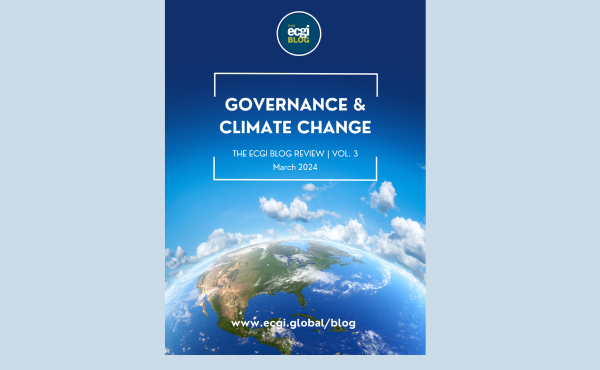
The ECGI blog is kindly supported by

Unbundling climate change risk from ESG
Perhaps the most important current development in corporate governance is the growing divide between the United States and the European Union on core questions of fiduciary duty when it comes to ESG. I want to describe this growing divide, to describe some of the underlying political economy that accounts for this difference, and to suggest its danger for the critical task ahead: the aggressive effort to reduce the level of greenhouse gas emissions necessary to avoid catastrophic climate change.
One important implication of this analysis is that we need to unbundle the mitigation of climate change risk from what is now called “ESG.” A further implication is that the efforts to use the tools of corporate governance on climate change risk should shift away from a primary attention on companies that produce and refine fossil fuels to a focus on companies, like auto companies, that make products that consume large amounts of energy. More generally, activists should devise strategies to press firms that use fossil fuels or make products that use fossil fuels to prepare for as-soon-as-possible transition to a net-zero economy.
Thus, one important task is to produce a separate net-zero transition index (an “NZT index”) that would measure how firms are addressing climate change risk, comparatively and over time. There are two problems with existing ESG indices: They reflect the arbitrary weighting of various ESG components, resulting in a dismaying lack of correlation, and they bundle diverse elements, which diverts attention from the element that must be prioritized, the mitigation of climate change risk. As the debate over quantifying “scope 3” emissions demonstrates, generating an NZT index is not automatic, but at least the target is clear and unconfounded by other objectives.
There are three critical drivers behind the prioritization of climate change over other elements of ESG and the case for unbundling. Driver one is the consensus among governments world-wide about first, the critical nature of the climate change threat and second, the general policy prescription: keeping global warming within a +1.5C cap and “net zero” emissions by 2050, ideally sooner. This consensus was reached by 196 parties at the Paris conference in 2015 and buttressed by a subsequent series of UN-sponsored conferences. Conference of the Parties (COP) 28 will be held in early December of this year in Dubai, in the UAE. Thus, corporate governance measures on behalf of the net-zero transition can legitimately be described as facilitating decisions of governments, not an example of a “democracy deficit.” Global corporate governance in this matter is congruent with global governance, not a substitute for the failure of governments to act.
This sort of global governance consensus, concerted follow-up, and concrete action plan does not exist for any other prospective component of ESG and is unlikely to exist because governments differ on social values and differ on trade-offs of social rights for economic development.
Driver two is the distinctive financial justification for addressing climate change and not necessarily other elements of ESG. This is because mitigating climate change risk reduces systematic risk across a portfolio of diversified investments. The disruptions associated with various realizations of climate change risk will spread across the entire economy and thus across a diversified stock portfolio; climate change risk is systematic. Addressing climate change risk can improve risk-adjusted returns for investors holding a diversified portfolio of equity and other investments. This pure financial case does not generally obtain for other elements of ESG. To address them propels us into the controversial realm of trade-offs, debates about investors’ utility functions, and contention about the duties of financial fiduciaries.[1]
Driver three for the unbundling of climate change from ESG is realpolitik. ESG in the United States has become embroiled in the culture wars. ESG is “woke,” which I suppose is an allegation that ESG – this diverse if not muddled package of environmental, social, and governance concerns – is all about making people feel bad about themselves, or is political correctness squared, or is simply a vehicle for the pursuit of another three-letter word, DEI, Diversity, Equity, and Inclusion, which parties use to make ESG all about race and gender.
As I will suggest later, the ESG culture-war attack has been fostered by those whose principal objection to ESG is precisely the climate change element. The point of the culture war is to disrupt a growing consensus about the importance of addressing the climate change threat by draping it in the now-controversial flag of ESG. The attack against ESG on culture war grounds carries the hope that climate change concerns will be collateral damage.
This brings me back to where I started: the growing divergence between the EU and the U.S. on ESG. The EU has adopted a series of far-reaching measures to take on various elements of ESG. These include:
1) A stewardship code for asset managers, calling for both engagement and screening with ESG in mind.
2) Sustainable financial disclosure regulation, imposing a “sustainability” disclosure requirement on banks and asset managers that means that any investment product needs to disclose the extent of sustainable investment.
3) A Corporate Sustainability Reporting Directive, which requires so-called “impact disclosure” of the effects of the company’s activity on people and the environment as well as financial disclosure pertaining to sustainability issues, so-called “double materiality.” These disclosure requirements apply to all public companies except for the smallest and to all large private companies. The disclosure requirements are meant to encompass the company’s supply chain.
These reporting requirements interact with the so-called “taxonomy regulation,” which purports to establish a framework to facilitate sustainable investment by providing common definitions and standards for “green investment” and thus to drive out “greenwashing.”
4) Finally, most recently, the EU is in the final stages of adopting a Corporate Sustainability Due Diligence Directive (“CSDDD”) which, to quote a law firm memo, “could require large companies to undertake due diligence on their own activities and that of their suppliers, and to identify and prevent, end or mitigate any actual or potential adverse impacts of their activities on human rights and on the environment.” If adopted this would create environmental and human rights due-diligence duties for companies throughout the companies’ supply chains. Companies could face public enforcement action and potentially civil liability for failure.
To say that these measures are far outside the ESG framework often invoked in the United States is to understate the matter. In the U.S., the big issue is whether pension funds can appropriately consider ESG matters in their investment decisions and whether state public pension funds will be barred from doing business with financial institutions that scale back their financing of fossil fuel expansion. President Biden issued his only legislative veto thus far to reject a proposed limitation on the Department of Labor’s permission for ESG considerations by a private pension-fund fiduciary. Eighteen states have adopted some version of anti-ESG legislation.
The Biden Administration came into office determined for the SEC to impose mandatory climate changed-related disclosure as a top priority. The current schedule calls for a “final” rule by October 2023, and we can anticipate contentious litigation.
These U.S. v. EU differences are vast. Still to be resolved are the EU requirements that will be imposed on U.S. firms with EU subsidiaries or branches. U.S. Treasury Secretary Yellin has publicly signaled formal U.S. concern. “While we’re supportive of the high level aims of the CSDDD we are concerned that it has extraterritorial scope and potential for unintended negative consequences for US firms,” she said in recent testimony before the House Financial Services Committee.
Two major issues of political economy underlie these differences.
First is the nature of retirement savings in the U.S. vs. the EU and, more generally, the differences between the U.S and the EU in the extent to which politically active citizens see a direction connection between stock market returns and their personal retirement security. In brief, in the U.S., state-provided pensions – social security – offer a thin level of retirement security for private sector employees. Defined benefit pension plans have been substantially phased out for most companies over the past 40 years.[2] Instead, retirement security is left to a mixture of personal savings (including plans where tax benefits provide an incentive to save) and company-sponsored defined contribution plans. Employees are given an incentive to participate in company plans through a combination of company match and tax benefits. In general the management of these plans is left to individuals, who see regular reports on their investment returns. Individuals’ retirement well-being thus materially depends on the success of their investment strategy, both through retirement plan savings and personal savings, and they come to have insight into factors that may affect investment returns. President Trump, an ace marketer, campaigned on the basis of how well voters’ stock market portfolios and defined contribution plans had prospered during his presidency.
“Millennials,” according to some survey evidence, have a stronger preference for ESG-tilted investment than older generations, but according to the latest tabulation of the Federal Reserve, this age cohort (<= age 40) has relatively little wealth (less than 10 percent of all assets) and even less ownership of equity (less than 3 percent of all equity). “Boomers” and older own approximately 75 percent of all equity. As a result, wealth accumulation is inversely related to remaining years of work; the impact of ESG-tradeoffs becomes more acute as retirement approaches; and the nature of retirement savings in the U.S. provides individuals with motive to become sensitive to the potential trade-off of ESG concerns for stock market returns. The political economy of ESG in the U.S. is thus constrained by this function: Willingness to substitute ESG benefits for pecuniary returns declines with age, but propensity to vote increases with age. This constraining function holds even though equity ownership is concentrated, and only 50 percent of the population has any pension assets.
The provision of retirement savings is altogether different in the EU and produces a different political economy function. As per a recent European Central Bank report, most retirement provision in the EU runs through member state-level PAYG plans. Pension payouts are funded by contributions paid by current workers; unlike state level public pension plans in the US, such plans do not accumulate funds that could be invested in equities. Robust private employer pension plans, “occupational pension plans,” are found only in the Netherlands and Germany. Although private pensions have given way to defined contribution plans in recent years, the overwhelming share of pension assets are held in defined benefit plans, approximately €2.2 trillion vs. €200 billion. The point is this: In a defined benefit plan, the risk-bearer is the sponsoring institution. Short of default, the payout stream does not vary in correlation with the return on the underlying assets; the sponsor is exposed to measures that affect returns, but the pension plan beneficiaries, the individuals, the voters, are not.
More generally, individual equity ownership is generally less prevalent and counts for a smaller share of net worth in EU countries than in the U.S.. A recent study showed that the stock market participation rate in the EU as a whole was approximately half of that in the U.S. (26 percent vs. 49.7 percent).[3] On a country basis, only Sweden (70.8 percent) and Denmark ((56.1 percent) had a higher participation rate; Germany’s, for example, was 25.4 percent. More striking was the much lower fraction of household net worth invested in the stock market for a given level of wealth, among those who owned stocks. For example, for median net worth households in the U.S. that held any stocks, the fraction of net worth in stocks was 30.5 percent and for the EU, 7.4 percent. We see a similar pattern of markedly less wealth invest in stocks even in high participation rate countries: Sweden, 14 percent; Denmark, 8.1 percent for median net worth households. Lower stock market participation rates and less wealth sensitivity to changes in stock values means that governments and firms will have greater freedom of action to take ESG measures that may affect stock market returns. This is enhanced by the extent of foreign ownership of EU companies, recently estimated at approximately 30 percent.[4]
Second, perhaps the crucial political economy explanation for the different approaches to climate change especially and for other ESG issues in the U.S. vs. the EU is that the U.S. is a petro-state, and the EU is the opposite. One way to demonstrate this is with statistics on crude oil production. In 2022 the US produced approximately 4 billion barrels of crude oil. This makes the US the world’s leading producer of oil, ahead of Saudi Arabia. In the EU, by contrast, crude oil production is miniscule, 125 million barrels in 2021. To cover the gap in energy use, the EU imported 750 million barrels of crude oil in 2021.
With the departure from the EU of the UK and its potential North Sea production after Brexit, no major EU state has a large stake in protecting domestic crude oil extraction as a source of local wealth and high-paying jobs. Indeed, in the EU, reducing oil consumption is favorable from a balance of trade perspective. Energy-consuming businesses may resist, because conversion away from oil to alternative energy sources may be costly, but this is a transition issue. Few businesses have a long-term stake in a high level of energy produced from fossil fuels. Thus, one would expect the political economy dynamics in the EU to facilitate a transition away from crude oil and other fossil fuel products
The situation in the U.S. is quite different. The average 2022 price of crude oil was about $100 a barrel, which means that the value of U.S. crude oil production was $400 billion. As a matter of scale, U.S. GDP that year was $25 trillion. The American Petroleum Institute, the industry’s trade association, asserts that as of 2021, the petroleum and natural gas industries supported 10.3 million jobs and accounted for 8 percent of the U.S. GDP. The American industry is famously concentrated, with major crude oil production in Texas and related refining activities throughout the Gulf States and the Southwest, but there is also significant production throughout the Rocky Mountain States. As of year-end 2021, proved crude oil reserves in the U.S. were approximately 36 billion barrels. Moreover, fossil fuel energy companies have comprised 5-10 percent of the market capitalization of the S&P 500 in recent years and a higher percentage of specialized market indices.[5]
The shift away from fossil fuels, particularly petroleum products, in the U.S. is thus not a matter of a transitional shift in industry consumption patterns but entails potentially a massive shift in wealth with far reaching political economy consequences. An additional complication is that a significant fraction, perhaps more than half of these U.S.-based reserves, is held by private companies. For example, the U.S. Energy Information Administration recently reported that the 53 publicly traded companies with large U.S. production collectively produced only about one-third of all U.S. crude oil in the quarter. This has significant implications for corporate governance. The influence of investors through the corporate governance machinery is limited to public companies. Without pushing too hard on the numbers, one can see how 1 or 2 trillion dollars of wealth tied up in crude oil is held by private owners, and these owners are unlikely to hold their oil wealth as a fraction of fully diversified portfolios with strong incentives to mitigate climate change risk. Indeed, private parties may benefit from the pressure on public fossil-fuel companies to shed assets.[6]
As a matter of comparative political economy, further note must be taken of the current constitutional protections of virtually unlimited political spending in the United States. This factor interacts with the substantial private ownership of fossil fuel assets.
The different regulatory approaches to climate change risk in the EU and the U.S. will inevitably reflect these fundamental differences of political economy, both in the importance of stock market returns to the voters and the importance of domestic fossil fuels production.
This brings us back to the need first, to unbundle climate change risk from ESG and then second, to focus on the users of fossil fuel and the producers of products that use fossil fuels.
Many believe that the backlash against “woke” is inspired by the parties who have an interest in protecting the fossil fuel industry. The pushback against climate change activism was stirred by political actors in the fossil fuel-producing states, especially Texas, for understandable reasons. Their target was banks that had indicated some reluctance to fund fossil fuel investments and asset managers that had sounded the alarm about climate change risks. But these parties have attempted to broaden the base against climate change activism by linking it to elements of ESG that can be culturally controverted. One strategy is to enlist groups with a broader portfolio, for example the State Financial Officers Foundation (SFOF), to engage on ESG more generally and in a way that links resistance to the “cultural” elements of ESG to climate change issues.
For example, the SFOF organized a May 15, 2023, letter to Larry Fink expressing concern that “taxpayers’ best long-term economic interests have become subordinated to environmental, social, and political interests often divorced from shareholder value – and often pushed through shareholder proposals.” The cited examples started with “shareholder proposals [that] would require companies to pledge fealty to the Paris Climate Agreement” but then moved to other social issues. Similarly, an attached nine page “Proxy Voting Questionnaire” started with questions about BlackRock’s response to proposals on climate reporting and reducing greenhouse gas emissions but then moved to the hottest hot-button issues relating to diversity or racial equity. The majority of the signers were officials from fossil fuel producing states but also included signers from other states.
The on-line magazine Smart Women Smart Money hosted by SFOF, carries a April 2023 article, “What Is ESG Investing?” that asserts that “ESG is impacting inflation,” through an increase in fossil fuel products “that will raise cost[s] … for decades to come” and adds that the same measures will be “adding burdensome costs to farmers and ranchers” that will produce increased costs as well. The article skips from a possible implication of a transition away from fossil fuels to worries about a “woke elite” and how “ESG can, unfortunately, undermine the U.S. Constitution by imposing mandates on people that voters don’t approve of at the ballot box.” It asserts that “ESG efforts can have a selective focus on en-vogue political causes. For example, some companies work closely with Chinese entities and ignore the truly alarming human rights and environmental records of these companies.”
The effort to link climate change with controversial positions on various social positions seems in service of a strategy to undermine a consensus about the urgent need to address climate change risks. This argues for unbundling climate change from other ESG concerns. A climate-change-focused index, such as the proposed NZT Index, is one way to do that. More generally, I think the most important target of corporate governance measures are the companies that either are heavy users of fossil fuel products, public utilities, for example, and the companies that now produce products that will be heavy users of fossil fuel products. At least some of the automobile companies are pivoting consistent with a net-zero transition but there are many elements in that supply chain.
Frankly it will be hard to change the behavior of public and private oil, gas, and coal companies. This is not to write off such efforts, either through divestment strategies or engagement strategies, because of the social importance of such efforts in solidifying a consensus around climate change imperatives.[7] Because of the direct connection between the danger and the target, such activity is effective for social learning and mobilization. Nevertheless, corporate governance activists in the United States should turn attention to the potential users of those products and the producers of high-energy consuming products, like automobiles and trucks, and their supply chains. For such producers, the cost of a climate-sensitive pivot is a transition issue, not the write-off of the logic of the business. Moreover, the genuine transition costs may be at least partially offset by the competitive advantages of an accelerated move. Additionally, focusing on the fossil fuel users and product producers will, by reducing demand, have a second order effect on the fossil fuel producers by encouraging internal divestment from fossil fuel production and exploration.
The approaches to ESG in the U.S. and the EU will differ significantly. This reflects political economy differences which also reflect differences in underlying values. What cannot differ is the commitment to addressing the risks of climate change. The planet can thrive with a diversity of social value choices but successfully addressing climate change requires a common effort. For this reason, climate change must be unbundled from the rest of ESG. It is singular and prior. Concretely, this can be reflected through a separate NZT Index, for example, and a corporate governance activism strategy with a new set of targets.
----------------------------------------------------------
By Jeffrey N. Gordon, the Richard Paul Richman Professor of Law at Columbia Law School, co-director of the Millstein Center for Global Markets and Corporate Ownership, and co-director of the Richman Center for Business, Law and Public Policy.
This article was originally posted in July 2023 on the CLS Blue Sky Blog.
If you would like to read further articles in the 'Governance and Climate Change' series, click here
The ECGI does not, consistent with its constitutional purpose, have a view or opinion. If you wish to respond to this article, you can submit a blog article or 'letter to the editor' by clicking here.
----------------------------------------------------------
FOOTNOTES
[1] For elaboration, see Jeffrey N. Gordon, Systematic Stewardship, 47 J. Corp. L. 627 (2023).
[2] See, e.g., Jeffrey N. Gordon, Employees, Pensions, and the New Economic Order, 97 Colum. L. Rev. 1519, 1546-1550 (1997).
[3] Dimitris Christelis, Dimitris Georgarakos & Michael Haliassos, Differences in Portfolios Across Countries: Economic Environment Versus Household Characteristics, 95(1) Rev. Econ & Stats. 220 (2013).
[4] European Commission, Foreign Direct Investment Report: Continuous Rise of Foreign Ownership of European Companies in Key Sectors, March 13, 2019.
[5] See Roberto Tallarita, The Limits of Portfolio Primacy, 76 Vand. L. Rev. 511 (2023).
[6] See, e.g., How a Houston Oilman Confounded Climate Activists and Made Billions, WSJ, July 11, 2023.
[7] See, e.g., Marco Becht, Anete Pajuste & Anna Toniolo, Voice Through Divestment (ECGI Fin.W.P. 900, March 2023), available at https://ssrn.com/abstract=4386469.







